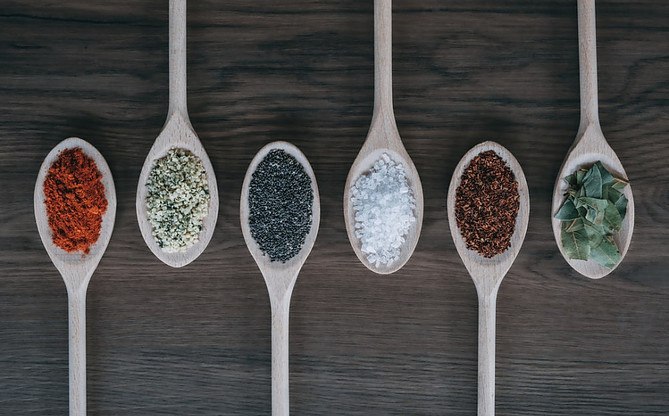This guide is all on chicken salt. It would be a valuable read for you, especially if you or your loved one is with high blood pressure or diabetes. Here you will learn answers to some interesting questions such as Does Chicken Salt Raise Blood Pressure?
People who have hypertension or diabetes should watch their blood pressure and their salt intake. If you are one of them, you should try as much as you can to get off or cut down the salt intake.
Salt is salt be it refined white salt, Pink Himalayan Salt, grey Celtic salt, Smoked Salt
etc. Does this also include chicken salt, though? Do you also need to cut down or stay away from chicken salt? Can chicken elevate blood pressure too?
We will be finding answers to all the above questions and more in this article.
Chicken salt! What does that even mean? Does that mean a salt with chicken taste or flavor? That was my reaction the first time I heard the word “chicken flavour”, and I am sure most of us thought the same way.
Most people are seeking for alternative seasoning to use as a salt substitute to minimize their sodium intake and reduce their risk of developing high blood pressure or heart failure.
Is chicken salt one of the alternatives? Is it healthier than the normal salt? We need answers to these questions before running off to our local grocery shops to stock up our Kitchen with this seasoned salt.
Let’s start with defining chicken salt…
What is Chicken Salt?
Chicken salt is an Australian most popular and favourite seasoning. Is a flavoured salt or salt spiced up with a blend of different spices and herbs?
It was developed in the 1970s originally for seasoning rotisserie chicken, to add color and a savory taste to the chicken.
Today this seasoned salt is now being used in fast-food restaurants to sprinkle on their fries, hot chips, and for marinating chicken, fish and meat.
What’s in Chicken Salt?
Chicken salt is not much different from other seasoned salt found in the US or UK. Although it is named the chicken salt, it does not contain any chicken in it but basically, salt with blends of herbs and spices.
For example, sea salt, onion, garlic, rice flour, paprika, and a blend of herbs and spices.
Depending on the brand and the blend of herbs and spices added to it, it has a different yellow to orange color. It was named the chicken salt because it was initially developed as a seasoning for rotisserie chickens.
The first recipe for chicken salt consists of garlic powder, onion powder, paprika, celery salt, chicken bouillon, curry and monosodium glutamate.
There are different versions of chicken salt – the ones with chicken flavours, the ones without and there is the vegan version too. The version and the number of ingredients depend on the brand.
Aside from the salt, the blend of spices and herbs used in chicken salt may include —
● Onion powder
● Garlic powder
● Paprika
● Black pepper
● White pepper
● Chill pepper
● Celery seed
● Kala namak
● Marjoram
● Oregano
● Mustard seed
● Thyme
● Sugar
● Tumeric
● Yeast extract
For the umami taste, soy sauce powder or monosodium glutamate is added.
Salt vs Chicken Salt – What is the Difference?
The difference is simple, as noted in the below table.
|
Salt |
Chicken salt |
|
No |
Herbs and spices are added to the chicken salt for additional flavour and nutrients. |
Effect of Salt on Blood Pressure?
When we consume salt, the food, liquid and stomach fluid dissolve the salt. Then the minerals are absorbed into our bloodstream when it gets to the small intestine. When the salt enters the bloodstream, it alters the electrolyte balance, stimulating a change in the body fluid. It helps to absorb and transport nutrients from food.
Salt is hypertonic in nature. It has a direct impact on the amount of liquid retained or released by the body. Most importantly, the amount of salt in your bloodstream determines your blood volume and consequently controls your blood pressure.
Salt attracts water. When we consume too much salt, in order to dilute it, our body absorbs and holds on to more water. This increases the blood volume and causing an increase in blood pressure. This puts a lot of stress on the heart as your heart works harder to pump more of this fluid into the blood vessels.
Salt vs. Sodium – What is The Difference?
Most times, salt and sodium are used interchangeably but, both are not the same.
|
Salt |
Sodium |
|
Salt is a chemical compound made up of 40% sodium and 60% chloride. |
It is one of the major component or element in salt. It is a very reactive chemical element. Sodium doesn’t exist free in nature but as a compound with other elements. |
|
Salt is the primary source of sodium and chloride in our diet. |
It is one of our body’s electrolytes |
|
It has been used for centuries for preservation and to enhance the flavor of our food. |
Sodium is essential for the proper functioning of the body. It helps to maintain a proper fluid balance, acid-base balance and plasma volume. Our body needs it to transmit nerve impulses and to contract and relax the muscle fibers. Sodium is also used in glass manufacturing in the textile industry, and in the manufacture of glass. |
|
Excess of it means too much sodium in our body. |
Excess of it in our body causes water retention and elevated good pressure, which increases the risk of cardiovascular diseases, stomach cancer, osteoporosis and kidney disease. |
|
Comes in many forms such as table salt, rock salt, kosher salt, sea salt and pink Himalayan salt. |
Also found in other food ingredients like monosodium glutamate (MSG), sodium nitrate (food preservative), soy sauce and sodium bicarbonate (baking soda). |
Salt vs Sodium Equivalents
Generally, the recommended sodium intake is 2,300 mg it less daily. The American Heart Association (AHA) recommends a sodium intake of not more than 1,500mg daily, especially for people with hypertension. So, it is important to know how much sodium is in the quantity of salt you consume, which will help you to understand how to control your salt intake.
For the regular salt, which has about 40% sodium
● 1 teaspoon of salt = 2,300mg of sodium
● ¾ teaspoon of salt = 1,725mg of sodium
● ½ teaspoon of salt = 1,150mg of sodium
● ¼ teaspoon of salt = 575mg of sodium
Effect of Chicken Salt on Blood Pressure?
One needs to beware of using chicken salt in excess since chicken salt is seasoned salt. The difference is that Chicken salt contains other herbs and spices that can add color and an umami taste to your meal.
Its advantage over plain salt is that you can use a smaller quantity of this seasoning to prepare a tasty meal that is not flavored with 100% salt. This also means the amount of salt you will be consuming will be reduced a bit. This does not mean that this seasoned salt does not have any effect on your blood pressure, though. It does! Because it contains salt as the primary ingredient.
Tip: There are many natural ways you can reduce your blood pressure. The below video explains how a mid-day nap can help you to reduce blood pressure naturally.
Does Chicken Salt Raise Blood Pressure?
Yes, chicken salt can raise or spike your blood pressure because of its salt content. Chicken salt depending on the brand, contains a relative amount of sodium (from the salt, monosodium glutamate and soy sauce).
For example
- Mitani chicken
This salt contains: 82% of sea salt, spices, rice flour, vegetable powder (natural garlic flavour, onion, yeast extract, anti-aging agent)
- MasterFood chicken salt
It contains: salt 75%, chicken flavour 10%, paprika, onion, food acid (citric), garlic, rice flour, pepper, celery seed and sesame seeds.
- Anchor chicken chippy salt
It is 70% salt, wheat flour, flavours, spices, bell pepper powder, onion powder, wheat starch, sugar, herbs, soy sauce powder, caramel colour (150c), favour enhancers (621, 635, 327), food acids (330), anticaking agent (341), maltodextrin (from corn and tapioca).
So, it is more advisable to use chicken salt sparingly in cooking, marinades and when sprinkling on your chips and fries.
How To Decide Which Salt is Better for Blood Pressure?
When we go shopping for groceries in a supermarket or a grocery store, most times, we may find aisles with different types and different brands of salt. Each being promoted by the manufacturer as the best or the healthiest, and you are now confused and wondering which to choose.
To help you decide which salt is healthier for the blood pressure, first, you need to know the different types of salt and the advantages each has over the others.
Let’s dig into each type now…
● Table salt
Most of us are more familiar with this type of salt. It is made of sodium and chlorine chemically bonded together. This type of salt is generally inexpensive, contains iodine with an anti-caking agent to prevent it from clumping together. But the problem with this salt, aside from the fact that it is chemically refined is, that it has the highest sodium content than the other types of salt.
● Kosher salt
This salt is similar to table salt, but its texture is more coarse and flaky. This salt is not iodized and can only be used for some method of cooking.
● Sea salt
This salt is extracted from the ocean. It contains important trace elements.
The downside of using this salt is that it may contain some impurities like microplastics and heavy metals.
● Himalayan salt
This salt has a characteristic pink colour with a hue of orange, which comes from the iron oxide contained in the salt. With a sodium content that is a bit lower than that of the table salt. This salt does not contain iodine.
● Salt substitutes
These are salt that contains a lower amount of sodium. The sodium is mostly substituted with potassium. They are also known as potassium salts.
The potassium salt is the best for people who want to lower their sodium intake. This salt is more expensive. Remember, the high intake of potassium also is not safe for some people.
So back to the answer to the question, how do we determine which salt is better for high blood pressure?
Aside from salt substitutes, every other type of salt contains amount the same amount of sodium. And there is no scientific evidence that proves that any salt that is healthier or better than the other. So, choose a salt depending on your budget and taste preference.
In as much as excess sodium is not good for our blood pressure, we also need it to balance our blood pressure and our body fluid. It is more advisable for us to choose an iodized salt since we need iodine in our diet, except if we are getting iodine from sources such as seafood.
Most importantly, monitor and cut down on your salt intake instead. Swap the salt with herbs and spices when preparing your meals.
What are the Better Salt Options for People With Hypertension?
If you have high blood pressure or sensitive to salt, it is advised that you cut down on your salt intake.
Most of us believe that our meals will be tasteless without salt, but the truth is that you can also use other salt alternatives to spice up your dishes.
Some examples of better salt alternatives you can use includes;
● Salt substitutes
The most popular salt substitute is potassium chloride salt.
Note that potassium salt has a slightly bitter metallic taste. So, only use it in food that their taste will not be evident.
● Herbs and spices
There are many natural herbs and spices you can use to season your food and reduce the quantity of salt added to your dish. We can also use blends of different herbs and spices to season our food.
The following are some herbs and spices and some of the food we can use them to prepare
✔ Rosemary and thyme for stews, sauces, soups, bread and as dressings
✔ Ginger for stir-fries, stews, sauces, smoothies and marinades
✔ Curry powder in stew, chicken, fish, and soup
✔ Nutmeg in sweet bread and custard
✔ Bay leaf in soups and stews
✔ Basil for pasta, soups and tomato sauce
✔ Mace in cauliflower and chicken soup
✔ Coriander add to soups and curries
✔ Coconut amino for rice, marinades, dipping sauces and stir-fries
✔ Garlic for soups, lamb and stir-fries
✔ Lemon zest or juice for marinades and salad dressings
✔ Black pepper in soups, pasta and savoury dishes
✔ Dill in fish, chicken, and potato salads
✔ Fresh onions and onion powder in stir-fries, stews, soups, salsas and dips
✔ Cinnamon
Add to mustard, puddings, curries, soups, tomato sauce and marinades
✔ Cloves
Tasty in baked beans and sweet bread
✔ Majoram
Works in lamb, beef, chicken, pasta, soups and cream sauce
✔ Nutritional yeast
Good for pasta and popcorn
✔ Balsamic vinegar
Works for marinades, soups, salad dressings and stews
✔ Paprika
Add to stews, tacos and nachos
Great as salad dressings
✔ Red pepper
Use in marinades, soups, pasta and pizza dressing.
✔ Parsley
For rice, salads and soups
✔ Sage
✔ Tarragon
Great in cream or butter sauces and in chicken salad.
Tip: Some say Chinen salt is a good salt alternative too. Learn more about Chinen salt in this video.
When Should You Limit Any Salt, Including Chicken Salt?
Our body needs just a little amount of sodium to function properly. And, limiting sodium intake is part of a healthy eating pattern. This will help to control or lower blood pressure and reduce the risk of cardiovascular disease, coronary heart attack, kidney disease and stroke.
For decades different health authorities have recommended that people should limit their salt intake to a certain quantity. However, there has been controversy about the quantity recommended since aside from the risk of overconsumption, there is also a risk of underconsumption.
The American Heart Association (AHA) recommends a daily sodium intake of not more than 2,300mg, which is about 1 teaspoon of salt and 1,500mg for most adults.
The Institute of Medicine (IOM) recommends a daily intake of 1,500mg of sodium for healthy adults, while World Health Organization (WHO) recommends consuming 2,000mg of sodium daily.
More so, people respond to sodium differently, and those who are healthy may not benefit from limiting their salt intake. Some research has shown that limiting salt intake in healthy people may be harmful and increase their risk of heart disease.
People with hypertension, diabetes, chronic kidney disease and older adults are prone to be more sensitive to the blood pressure raising effect of salt. If you fall into this group, it is recommended that you limit your salt intake.
It is also advisable for you to limit your salt intake if your doctor or a registered dietician instructs you should do so for any medical reasons.
Conclusion
Chicken salt is basically a seasoned salt initially created in South Australia with the intent of adding more flavour and colour to rotisserie chicken. However, today it is used generally as a seasoning to add flavour not only to chicken but as a marinade and to sprinkle on chips and French fries.
A lot of people are wondering if the use of chicken salt is better than the normal salt for blood pressure. But the truth of the matter is that chicken salt is salt with added herbs and spices.
So, the key to consuming this seasoned salt is to use it in moderation. Because overconsuming it has the same effect on blood pressure as overconsuming regular salt.










